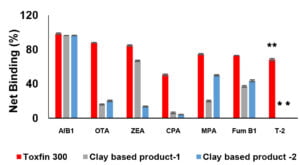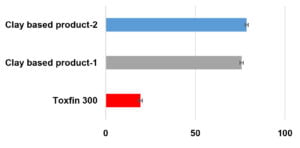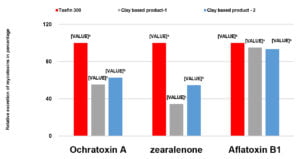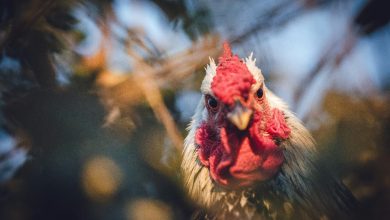IMPORTANCE OF A BROAD -SPECTRUM TOXIN BINDER FOR MAINTAINING HEALTHY GUT MICROBIOTA
Rajendra Moorthy and Nabila Fatima
Research & Development,
Kemin Industries South Asia Pvt. Ltd., India
Introduction
Profitability of poultry farming depends up on faster growth of the birds, breast meat yield, efficiency of feed conversion rates and lower mortality and morbidity rates for broilers, quality and quantity of egg production for layers. Plant based materials such as corn, soya, wheat bran, etc., are used as a major ingredient for animal feed preparation. These ingredients are usually prone to toxigenic fungal attack, leading to contamination with single or multiple mycotoxins. It has been proved by various studies that mycotoxins are having carcinogenic, estrogenic, immunotoxic, nephrotoxic, hepatotoxic and neurotoxic effects on animals and the effect is more pronounced, when multiple mycotoxins are present. These effects can lead to a significant loss in profitability of poultry farming. Several researchers have investigated the mode of action of various mycotoxin and the pathways associated to pathogenesis. In addition to the direct toxic effect on the host cells, some recent reports suggest that mycotoxins have a negative effect on beneficial gut microflora also.
Role of gut microbiota on health status of the animals
The gastrointestinal (GI) tract of chickens harbor diverse and complex microbiota that plays a vital role in digestion and absorption of nutrients, immune system development and pathogen exclusion. In addition to this, the integrity, functionality, and health of the chicken gut depends on many factors including the environment, feed, and the GI microbiota. It has been reported that gut microbial diversity can be improved by probiotics. Probiotics are single or mixed cultures of live non-pathogenic microorganisms, when provided in adequate amount confers benefit to the host. Probiotics currently being used are Bacillus subtilis, lactic acid bacteria (LAB, eg.: L.plantarum), Streptococcus thermophilus, Enterococcus faecium, E. faecalis, Bifidobacterium spp., fungal strains such as Aspergillus oryzae and yeast (Saccharomyces cerevisiae). Teo et al., have reported that broiler birds fed with B. subtilis (PB6) had heavier bursas and heterophils with higher in vitro phagocytosis for E.coli. This indicates the role on chicken innate immune system possibly by supporting gut microflora. Such findings indicate that the interactions between animal and gut microbiota is fundamental to poultry health and production.
Interaction between mycotoxin and the gut microbiota: Bi-directional effect
Alteration in the GI gut microbiota is caused by non-infectious and infectious stressors. The non-infectious factors include environmental stressors, nutritional imbalances, dietary changes, mycotoxins, poor management, enzymatic dysfunction, or host genetics. Infectious factors include viral or bacterial challenge, coccidiosis, or toxic metabolites produced by harmful microorganisms such as Clostridium perfringens. Mycotoxins being a non-infectious stressor, have been demonstrated for modulation of gut microbiota composition. Such alteration in gut microbiota can be observed up to species level in some of the studies. In another study, it was found that each mycotoxin has differential growth inhibiting effect on bacteria on exposure to mycotoxins (Table 1). In a study reported by Ali-Vehmas et al., mycotoxins slowed down the growth of microorganisms indicating the possibility of antimicrobial effect.
Table 1 shows the microbial sensitivity of mycotoxins.
| Mycotoxin | Microbes shown sensitivity | Microbes shown insensitivity |
|
Aflatoxin B1 |
Bacillus subtilis, B. thuringiensis, B. pumilus, B. brevis, and B. cereus | Steptococcus aureus, E. coli, Salmonella typhimurium and Saccharomyces cerevisiae |
|
Ochratoxin A |
B. brevis, B. cereus |
B. subtilis, B. thuringiensis, B. pumilus, S. cerevisiae and E. coli |
|
Cyclopiazonic acid |
B. subtilis, B. thuringiensis, B. pumilus, B. brevis, and B. cereus | Streptococcus aureus, E. coli, Salmonella typhimurium, S. cerevisiae and E. coli |
|
Zearalenone |
B. brevis, B. cereus and B. subtilis | B. thuringiensis, B. pumilus and E. coli |
|
T-2 |
S. cerevisiae |
B. subtilis, B. thuringiensis B. pumilus, B. brevis, B. cereus and E. coli |
Beneficial bacteria such as B. subtilis and B. pumilis was found to be sensitive to aflatoxin B1 (AfB1), cyclopiazonic acid (CPA) and zearalenone (zea), whereas T-2 was sensitive to S. cerevisiae. Ochratoxin A (OTA) was sensitive to B. brevis and B.cereus. None of the tested mycotoxins were reported to be sensitive to E. coli and Salmonella. Though mycotoxins shown sensitivity to the microbes, the extent of sensitivity depends on the concentration of mycotoxins and the environment it is exposed to. The reported effects of most of the mycotoxins are negative in terms of intestinal health accompanied by an increase of the gut pathogen. In addition to this, alteration in composition of intestinal microbiota of ileum was also reported in broiler birds administered with FB for 15 days. In contrary to this, microbes attack mycotoxins by either adsorption or biotransformation mode also and thus mitigates the toxic effects of mycotoxins. Reports on gut microbiota eliminating mycotoxin from the host naturally also exists, provided that the host is healthy with a balance gut microbiota. Such findings convey that, mycotoxins and microbes have bi-directional effect.
Occurrence of mycotoxins
United Nations Food and Agriculture Organization and the World Health Organization has estimated that 25% of the world’s crops such as nuts, cereals, and rice are contaminated by mold and fungal growth.Kemin Customer Laboratory Services test mycotoxin levels in animal feed samples and raw materials regularly. An analysis of the results obtained over the past years showed that about 85% of the samples were contaminated with either single or multiple mycotoxins and approximately 45% samples had mycotoxin contamination beyond the safe limits set by European Food Safety Authority (EFSA). The most common mycotoxin present in the feed samples were AfB1, OTA, FB B1, zea, T-2, CPA and DON. The emerging mycotoxins, CPA and MPA are also seen in the animal feed which can cause substantial loss in the farming.
Need of broad-spectrum toxin binder
Considering that most feed samples are contaminated with multiple mycotoxins, a broad-spectrum mycotoxin binder is required for eliminating the risk. An ideal mycotoxin binder for animal feed application should have several qualities. First and foremost, it should have high binding efficacy against all common mycotoxins. It needs to be noted that poultry GI system has different pH at different locations and the binding should be intact when the feed passes through the GI system. Secondly, it should not bind to essential nutrients present in the feed such as vitamins and minerals. This is very important as materials such as charcoal show high binding efficacy against nutrients. It is also important to note that the mycotoxin binder should not get digested/degraded while passing through the GI tract as it can lead to release of the bound mycotoxins.
TOXFIN™ 300
Kemin Agri foods India launched Toxfin 300, a broad-spectrum toxin binder composed of hybrid nano-silicates (HNS), activated clays and organic acids. Toxfin 300 was developed and tested using biphasic in vitro assay in context to poultry with mycotoxins and vitamins. It was then further evaluated by conducting in vivo binding studies in broiler birds using mycotoxin excretion method. The biphasic in vitro assay involves adsorption at pH 3.0 simulating the pH of crop and desorption at pH 6.8, simulating the pH of intestine. Based on adsorption and desorption, net binding was calculated. The binding efficacy of Toxfin 300 and other products having different actives towards mycotoxins are shown in Figure 1.
Figure 1. In vitro binding efficacy of mycotoxins for the products. Mean+/- standard error (n=3). *Analysis not done; ** – Data represents adsorption at pH 3.2
The result shows, Toxfin 300 containing HNS and activated clay as key ingredient performed much better than the products having other raw materials. It was also observed that though the products having HSCAS as active showed good binding towards AfB1, they did not show high binding efficacy for other mycotoxins.
Toxfin 300 was then tested with vitamin B6 using the same procedure along with products of different actives and the results are shown in Figure 2. Among the tested products, Toxfin 300 showed the least binding. It was also observed that clay-based product exhibited high binding to vitamin B6.
Toxfin 300 binding efficacy towards mycotoxins was also confirmed using in vivo excretion study in which the feed contaminated with mycotoxins (OTA-100 ppb, zea-100 ppb and AfB1-50 ppb) admixed with the products of different actives was fed to birds after starvation. Then the excreta were analyzed for toxin content and the results are shown in Figure 3.
Figure 2. In vitro net binding efficacy of products towards vitamin B6. Each experimental data represents mean net binding +/- standard error (n=3).
Figure 3. In vivo mycotoxin binding study with broiler birds. Data shows the relative percentage excretion of mycotoxins with respect to Toxfin 300 (mean, n=12). Superscripts with different alphabets denotes statistical difference between the products (p<0.05).
Toxfin 300 group showed higher excretion of all the mycotoxins among the tested products. All the products showed similar excretion efficacy for AfB1, whereas for OTA and zea, Toxfin 300 outperformed.
Conclusion
It is well established now that mycotoxin contamination in animal feed is very common. The levels of contamination and number of mycotoxins present may vary from time to time. Mycotoxins have growth inhibiting effect on beneficial bacteria and thereby they can alter the gut microbiota, which plays a major role in maintaining the intestinal health and overall health of the bird. So, it is essential to use a broad spectrum, efficacious mycotoxin binder in the animal feed, even when low levels of mycotoxin contamination are detected.







